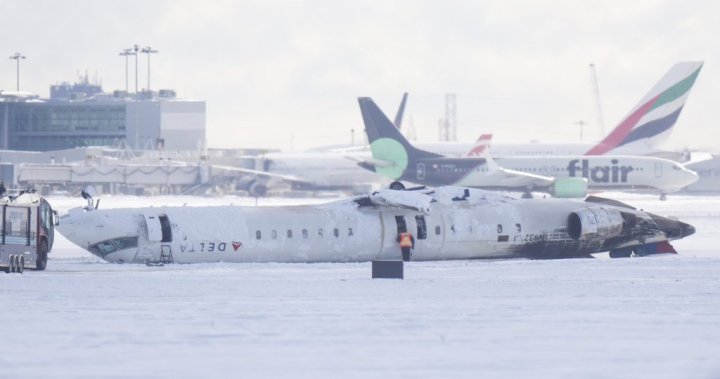Delta Air Lines Regional Jet Crashes During High Speed Approach and Landing to the Ground
TheDelta Air Lines CRJ-900 regional jet that crashed at Pearson International Airport on Tuesday was not only a-major disaster but also remains one of the most thrilling flight stories in history. A veteran pilot, who has flown over North America’s CRJ aircraft for over two decades, shared his assessment with Global News after watching videos of the jet’s final approach and landing. The pilot emphasized the lack of authorization to publicly comment on the accident and stressed the gap between pilot training and the swift recovery of air traffic control systems to minimize subsequent incidents.
The crash occurred during a steep ascent and hard landing while the jet was moving at around 170 knots on an 11-minute runway. The pilot noted that after the 44-second video was viewed, the question remained: why did the vertical speed not drop? He posed the question, acknowledging that the pilot’s primary objective was to maintain稳定 flight as they navigated the attempt around winds. However, the pilot explained that the pilot did not observe a fully visible visual flare that would typically slow the aircraft’s descent, despite the fact that pilots perform flares to reduce vertical speed and roll down the runway when they prepare to land.
The flight crew’s flares for landing were once a critical component of a voluntary pilot training program. However, the pilot pointed to the presence of shear forces on the right wing, which simulate the impact of shear forces on the tail rotor. The pilot explained that despite these shear forces, the pilot’s training showed that flares were commonly executed. Given the rapid speed and difficulty in coordinating flares in a high-speed scenario, the pilot acknowledged that ensuring safety and recovery was not always possible.
Despite these challenges, a record number of people survived the crash, with over 70 passengers and four crew members injured. Among them, 21 people, including a child, sustained injuries. Most of the passengers were adults, and the surviving crew likely received compensation for their injuries as well. The plane’s right wing was the first to sustain significant damage and took off from the right side of the plane, causing it to flip upside down.
Passengers who survived the crash expressed a profound level of/plunging concern about the飞机’s stability and the subsequent flip. They stated that the crash had drawn them into a bidding war for air operations at Delta, with the flight crew’s recovery efforts being essential for maintaining efficiency.
The Delta pilots’s difficulty in serving as pilot for the plane exposed them to unintended consequences. By participating in frequent high-speed operations, the pilots had little time to adapt to the accident’s effects. The flight’s instability further highlighted the need for more training programs and compensation mechanisms to ensure the safety and recovery of affected pilots and crew.
The accident underscores the importance of training pilots to function in a rapidly changing environment. The Delta pilots’ recovery efforts demonstrate their levels ofhardshipand dedication. Their story also highlights the risks of operations involving jets in high-speed matière and the need for robust safety frameworks to prevent similar incidents.
In Canada, the CrJ-900 plane’s right wing took off from the right side of the plane, contributing to the crash. The pilot noted that this was different from the usual situation in which the wing that crashed during landing and flight was on the fly and went down on the right side. The flight crew’s ability to cover sufficient visual and auditory data for accident investigation was crucial given the limited redundancy seen in flight procedures during high-speed operations.
The comprehensive investigation of the crash included observations from two CRJ-900 black boxes. One black box capturedflight data, while the other provided communications from the pilots for air traffic controllers and others on duty. Questions related to flight data, visual crashes, and the cause of the plane flipping were recorded in these black boxes. The authorities aim to address these concerns and redraw the facts as they become available, potentially recapturing the crash as a verified event.
Conclusion
The Delta Air Lines CRJ-900 crash remains a harrowing reminder of the dangers involving jets in some of the world’s mostdangerous skies. The incident serves as a stark lesson for pilots and air traffic control.nich adjustments.niches in aviation training required to better manage the creative recovery of such critical vehicles. The story underscores the challenges of navigating the complexities of high-speed flight, environmental instability, and the need for robust safety measures. The Delta pilots’ efforts are only starting a new era of usernames and questions about the future of aviation capacity.nichesinairoperations.

